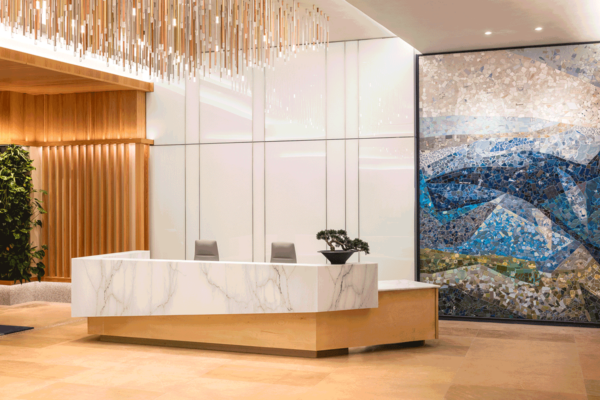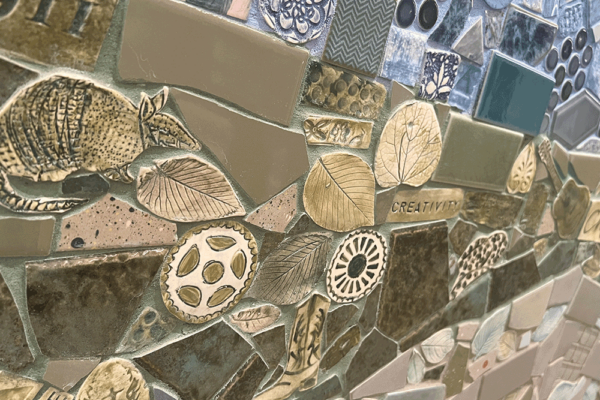“Artwork has been part of urban projects for decades, but a new push from developers looking for ways to drive foot traffic has created a boom for the art world,” says the New York Times in an article about the “love affair” between commercial real estate and art.
Our project for 1121 At Symphony Square is featured prominently in the article, “Creating an Artistic Buzz, One Real Estate Development at a Time,” which quotes developers from across the country who see art as a crucial way to differentiate their properties in a highly competitive market.
Gallery: A mosaic commissioned for 1121 at Symphony Square is highlighted in the New York Times as an example of developers using art to connect with the local community. Click an image to see the project.
“Growing interest in public art for private projects is altering the face of city centers across the country. The presence of art in real estate developments ‘drives traffic and engagement,’ provides an amenity for office employees and increases sales for retailers, said Michael Phillips, president of Jamestown, an international real estate firm and creator of the rotating art program that includes the display in Industry City,” a 6-million square-foot mixed-use campus in Brooklyn.
“Artwork has been integrated into urban development for decades to help stimulate economic recovery, exemplified by the Depression-era pieces of Works Progress Administration artists that are still visible in many buildings.”
“I believe that if we didn’t have art, people would walk in and say, ‘This is very nice, but I’d rather either work from home or stay where I am.'”
— Lee Brodsky, CEO, BEB Capital, New York
“Now, postpandemic, sentiments have changed yet again, as developers, in a bleak office market, are adorning their projects with art of all shapes and sizes as they look for ways to attract people who might want to shop, eat, live or work in the area.”
“A recent study by the University of Cincinnati found foot traffic in areas of the city featuring murals and sculptures increased three times when compared with Cincinnati neighborhoods without art displays. Specifically, in areas with commercial amenities, such as cafes and restaurants, foot traffic is 43 percent higher in locations with murals than in those without.”
“Lee Brodsky, chief executive of BEB Capital, called the current office market ‘the hardest office market, at least in my lifetime.’ Consequently, he installed a 15-foot mural outside the company’s building in Port Washington in New York, in an attempt to boost ‘curb appeal,’ he said, and attract more office tenants looking for a neighborhood with cultural cachet.”
‘I believe that if we didn’t have art, people would walk in and say, “This is very nice, but I’d rather either work from home or stay where I am,”’ Mr. Brodsky said.”
“From Day 1, we set aside money in the budget for artwork, and we hadn’t done it before to this scale, but we’re really glad we did,”
— Steven Charno, President, Douglaston Development, New York City
“Developers have also increasingly installed art in residential buildings as a popular amenity to help draw tenants. Steven Charno, president of Douglaston Development in New York, said art had become a ‘significant investment’ in his company’s portfolio, including at 3Eleven, a 60-story residential property that opened in Manhattan in 2022.”
“’From Day 1, we set aside money in the budget for artwork, and we hadn’t done it before to this scale, but we’re really glad we did,’ Mr. Charno said, noting that artwork ‘helps to differentiate us’ from competitor buildings in the same neighborhood. ‘We think it makes a big difference.’”
“’Jonathan Rose, founder and president of Jonathan Rose Companies, which co-developed Sendero Verde, a three-building residential project that opened recently in East Harlem, said artwork helped establish ‘a deeper connection’ to the culture and history of the neighborhood. Sendero Verde, which includes more than 700 affordable housing units, features two outdoor murals by the Hispanic artists Maria Dominguez and Betsy Casañas portraying the native plants and history of the area dating to the Indigenous Lenape people.”
Our project at 1121 at Symphony Square is cited in the article as an example of developers using art to connect with the local community.

Image: An external mural at 1121 At Symphony Square inspired by the neighborhood’s musical heritage and the wildlife that enlivens Waller Creek. Click the image to see the project at 1121 At Symphony Square featured in the New York Times.
“On a terrace at Symphony Square, a mixed-use development near downtown Austin, is a large abstract mural,” the article says, noting that it was painted as a tribute to the city’s music scene and Waller Creek, a 6.7-mile tributary that cuts through the heart of downtown.
1121 At Symphony Square Client Feedback
Being highlighted in the New York Times is just one more way that the developers of 1121 At Symphony Square are reaping the benefits of the art package we helped them procure.
Contact us to discuss how the art consultants at Art + Artisans can put our talents to work for your development.
“I can confidently say that the art program that A+A has introduced at 1121 @ Symphony Square has direct, positive impacts on our building, the customer experience and how the building is perceived by both prospective occupiers and the community as a whole.”
— Charlie Musgrave, Vice President, Leasing, Office & Life Science, USA, Ivanhoé Cambridge
See the art package at 1121 At Symphony Square
Read the New York Times article: Creating an Artistic Buzz, One Real Estate Development at a Time [NYTimes.com]



